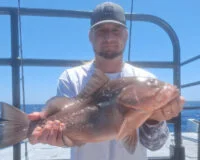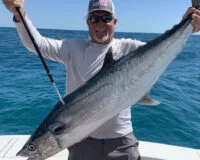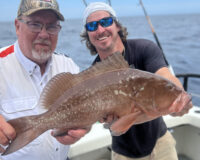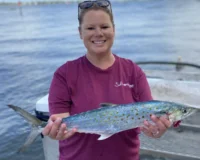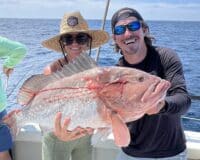Hubbard's Slow Pitch Jigging (SPJ) Only Trip
This was a special trip where we left our bait at home and didn’t take anything with us besides some metal jigs and specialty rods for a unique public slow pitch jigging trip aboard our Flying HUB 2! We have done a few private charters using this style of fishing, but never have we offered a public party boat style trip where guests could book individual spots for SPJ (slow pitch jig) fishing. As it turned out, we did really well while using this unique tactic and technique to jig up some grouper and snapper.
I am by no means an expert at this style of fishing, so this trip was a great learning experience for me, and I was blessed to be fishing with some real experts in the game of slow pitch fishing. I learned quickly how to set up the jigs, work the jigs, and fight the fish on these extremely light rods and reels. I was using our temple reef levitate Nabla rods from the shop paired with the Daiwa saltiga 35JH reel that is coming into the shop soon. Then I used our JYG, Johnny’s Jigs and some NLO jigs that we have limited supplies on, so get them now! <-visit our shop
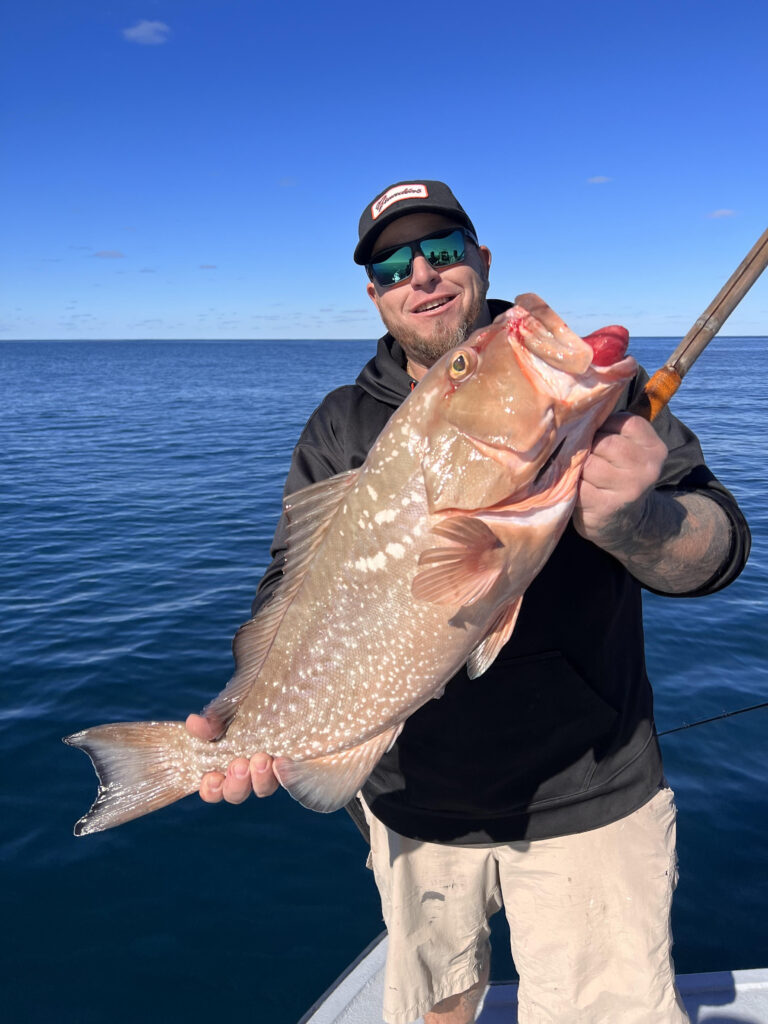
One big thing I had to learn was how to work the jigs without getting the light braided line wrapped around the tip of the rod. These specialty rods are all about the ‘recoil’ that will cause the jig to produce the action you’re looking for. However, what I didn’t know is that same recoil will often cause the line to wrap around the tip of the rod and if that happens and you hook up, snap goes that super light rod tip in an instant. Due to this, I spent most of the morning trying to account for wind and use that to keep the braid from the tip. However, after much trial and error I was finally told the secret of ‘following the line’.
You don’t need to jerk way up and then instantly lower the rod tip. You can lower the rod after working it up much more slowly, just fast enough to keep the line slack. This is called ‘following the line’ and allows the jig to work but prevents excess line from entangling your rod tip. This takes extreme concentration on every movement of the rod tip and line and was a much more involved style of fishing which was super entrancing and definitely locks your attention.
Another big mistake I made at the start was ‘over working’ the rod I was raising it up 60-80 degrees trying to get the jig a lot of motion when I learned quickly from watching the more experienced anglers on the boat that you only work the 15-30 degrees up to get the motion on the jig and keep it closer to ‘bouncing the bottom’.
If you’re trying to target grouper, snapper, and other bottom species pulling way up on the rod will sometimes prevent them from having a shot at hitting the jig unless they are super aggressive. While smaller movements keep the jig interacting with or staying right near the bottom. Occasionally I would reel a quarter crank or half crank while the jig fell to move the jig off the bottom some but after doing this 10 times or so I would drop it back down till it hit bottom and stay on the bottom awhile before working slowly off the bottom. This seemed to give me great results at not only the more bottom orientated grouper and mangroves but also the vermillion, almacos, and of course the pesky red snapper I was trying to avoid.
I also learned about how you can vary your approaches but doing some smaller movements, some larger movements, and sprinkling in a mixture until you find what works.
Another big learning moment for me was learning to adjust the jigs and when to adjust the jigs. The common rule of thumb is one gram for every foot of water, but if the current is lighter or drift is slow you can go way lower. For example, we were fishing around 200ft so being a novice I went right to a 200gram jig but noticed the guys catching fish were using much lighter 100-150gram jigs since our drift was so slow.

The color of the jig was also cool to learn about. Early morning, lower light conditions the glow striped darker color jigs seemed to work well while later in the day once it became brighter, we saw the more shimmering or reflective jigs without glow working better with brighter colored jigs too. However, we were all working together shouting out what jig, what action and what weight and color it was when a really nice fish came up and sharing intel allowed the boat to hone into what was working in each area and depth as a team.
Finally, something I have always thought to be true held true here too, the more natural color patterns or the wild ones that mimic a more natural pattern seemed to be most productive. That’s why a lot of guys really liked those NLO jigs that are made to look like the natural baits out there. Due to this, I ordered a huge line of these jigs for our shop the day after the trip. Many of the most experienced jig fisherman liked those glow striped darker jigs in the morning, brighter more solid jigs during mid-morning and then very realistic or reflective jigs during the day it seemed.
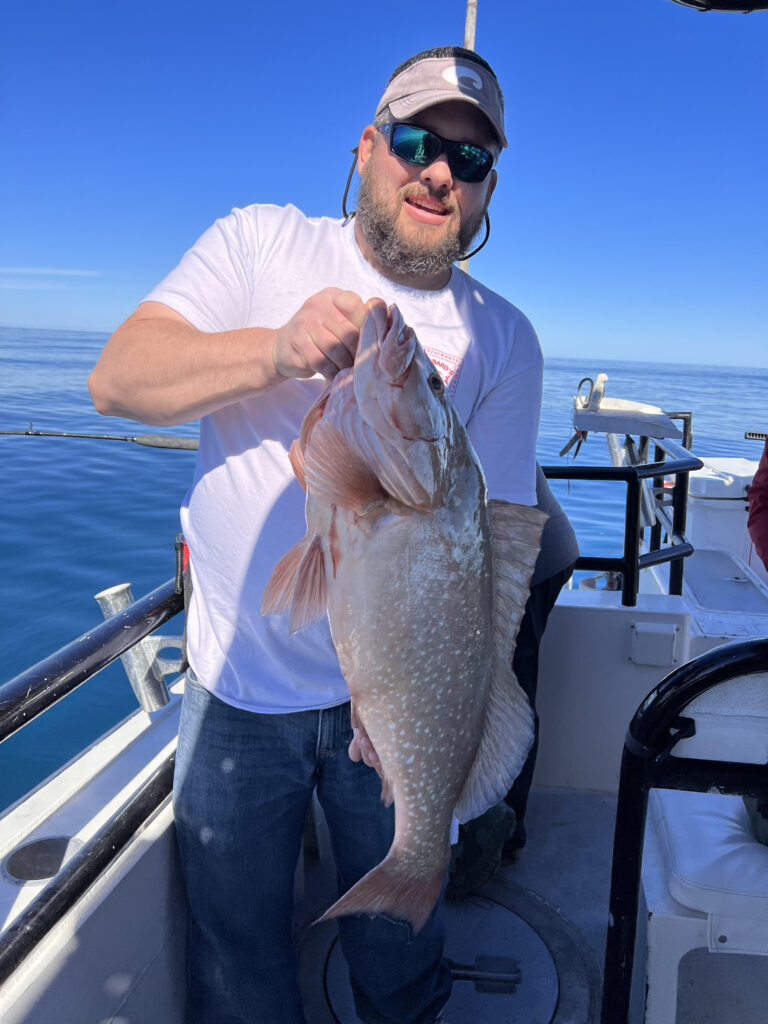
Also, hook sizes, you need a variety of hook sizes to match up with your jigs. Some were using as small as 2-3ot assist hooks for the smaller fatter jigs while the same weight jigs that were longer and taller were rigged with 4-5ot hooks. The main goal was keeping your hooks from getting near each other since most are rigging assist hooks at the top and bottom of the jigs when fishing less than 300-400ft of water. Only once getting super deep do they start going to assist hooks only on one side or the single assist hooks. That was yet another big learning curve.
Needless to say, I got a big jolt of slow pitch knowledge in a very short time, and I look forward to planning more of these trips in the near future! We will be coming up with a February date once I can sit down and make sure I can schedule it on a day I can join!
Until next time, Tight Lines.



